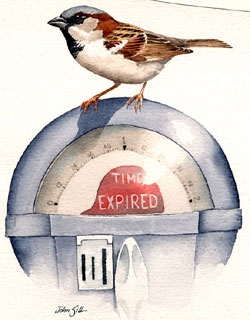Find a Bird - BBA1
Breeding Bird Atlas 1 Species Accounts
House Sparrow
Passer domesticus
Egg Dates
April to August
Number of Broods
two or three

This Old World native was introduced and reintroduced at many locations in North America starting in the 1850s and by about 1910 had spread throughout nearly the entire continent. The introduced birds took advantage of urban and rural habitats, aggressively driving out native hole-nesting species such as the Purple Martin, House Wren, Tree Swallow, and Eastern Bluebird and evicting Cliff Swallows from their mud nests.
House Sparrows are in the weaver family, a large and varied group of Old World passerines characterized by heavy seed-eating bills, communal behavior, and a predilection for nesting in cavities or ovenlike nests constructed of grasses, roots, and bark.
In urban settings, House Sparrows appear to have depended greatly on horse droppings as a source of undigested grain for food. The bird was abundant in the 1920s, when horses were still relatively common in cities and towns, but subsequently declined in numbers throughout the East, probably due in part to the disappearance of horses. Large numbers of the birds still persist in poultry yards and feedlots where there is plentiful grain.
House Sparrows are not migratory, although the young wander to some extent. Though they use holes, their nesting requirements are extremely variable both as to location and season. Some individuals appear to be able to breed at nearly any time of year. Bent gives a record of a nest containing naked young in Utah on January 1, but most breeding dates range from April to September, with three broods normal as far north as Massachusetts and Maine. Early nesting is one of the major reasons that House Sparrows have been able to displace more “desirable” native birds. They are also very aggressive in laying claim to a potential nest site and will destroy the eggs and young of any competing cavity nesters.
The House Sparrow has no real song, although on occasion some individuals may produce a series of pleasing notes. The typical vocal repertoire consists of a variety of chirping notes and chatterings. One of the commonest calls is a chissick, chissick series, which may be repeated incessantly, especially early in the morning. The young give a similar call when they are begging for food. When agitated, the birds scold with a rapid tut-tut-tut.
The courtship displays of the House Sparrow are vigorous affairs, with one or more males chirping steadily, hopping about with outstretched, quivering wings before a female. If the female flies, they pursue her, vigorously battling with one another, seemingly oblivious to their surroundings. The female may be quite defensive, biting the head and wings of one or more of her suitors.
In Massachusetts, nest construction may begin in late winter, with the earliest recorded date being February 18 (CNR). Nests are placed in nest boxes, streetlight fixtures, ivy-covered areas on buildings, and a variety of other nooks, holes, and crevices on buildings, walls, etc. Eleven Massachusetts nests were located as follows: nest box (5 nests), crack in brick wall (1 nest), between air vent slats (1 nest), inside shed (1 nest), hole under eaves or roof (2 nests), house gutter (1 nest). Heights ranged from 4 to 18 feet, with an average of 8.9 feet (CNR). House Sparrows inhabit urban and suburban areas and settled rural regions, but they avoid forested habitats, which lack both suitable nest sites and an adequate food supply.
The nest is a bulky, ovenlike structure, constructed of coarse grasses and dried weeds then lined with finer materials such as feathers, cord, hair, string, or bits of paper. Although as many as nine eggs are possible in a clutch, the average number per nest is four or five. Clutch sizes for 5 state nests were three eggs (1 nest), four eggs (2 nests), six eggs (1 nest), eight eggs (1 nest) (CNR, DKW). Eggs are oval and variable in color, from whitish to blue or green, with overall brownish speckling. Incubation, by the female, lasts about 12 days. In Massachusetts, most records of eggs are from April to September, but there are a few earlier and later dates (EHF). Egg dates from a sample of 11 state nests ranged from May 3 to June 23 (CNR).
Hatchling House Sparrows are naked; the young begin to attain feathers by the sixth or seventh day and leave the nest after 15 to 17 days. Whereas the food of adults consists of 97 percent vegetable material, mostly seeds and grains, the young are fed almost 60 percent animal foods, mainly insects. Nestlings in the Commonwealth would be ex- pected from early spring to early fall and were recorded from May 17 to August 7 in a sample of nests at Cornell University. Brood sizes for 7 state nests were three young (3 nests) and four young (4 nests) (CNR). Newly fledged young were observed from May 26 to July 6 (CNR), but, again, the actual range is much greater.
After nesting is completed, House Sparrows begin gathering in flocks, which persist until the next breeding season. They are particularly noisy at their communal winter roosts, where their simple, coarse tchlay calls combine into loud and persistent rounds. Hundreds of birds, swarming around inside low bushes or small evergreens, suggest the presence of a predator, but close inspection reveals only an excited group of sparrows.
Map Legend and Data Summary
Atlas 1 data collected from 1975-1979


Note: common around most areas of human habitation, especially farmland
Soheil Zendeh



